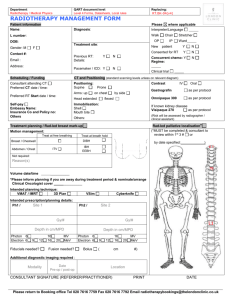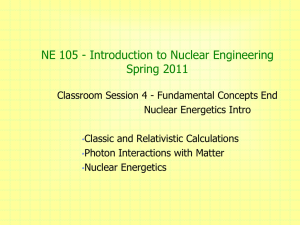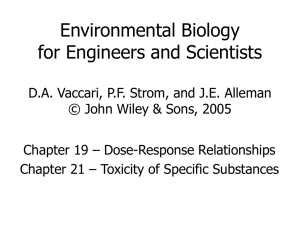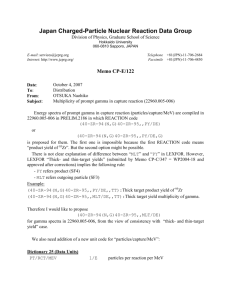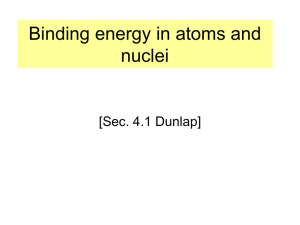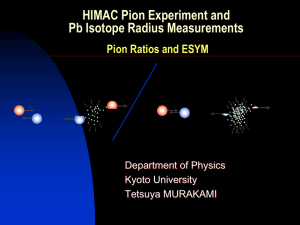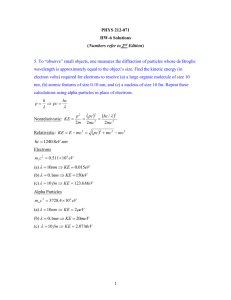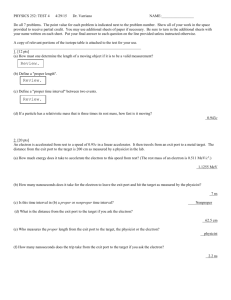Chapter 39 - Josefo
advertisement
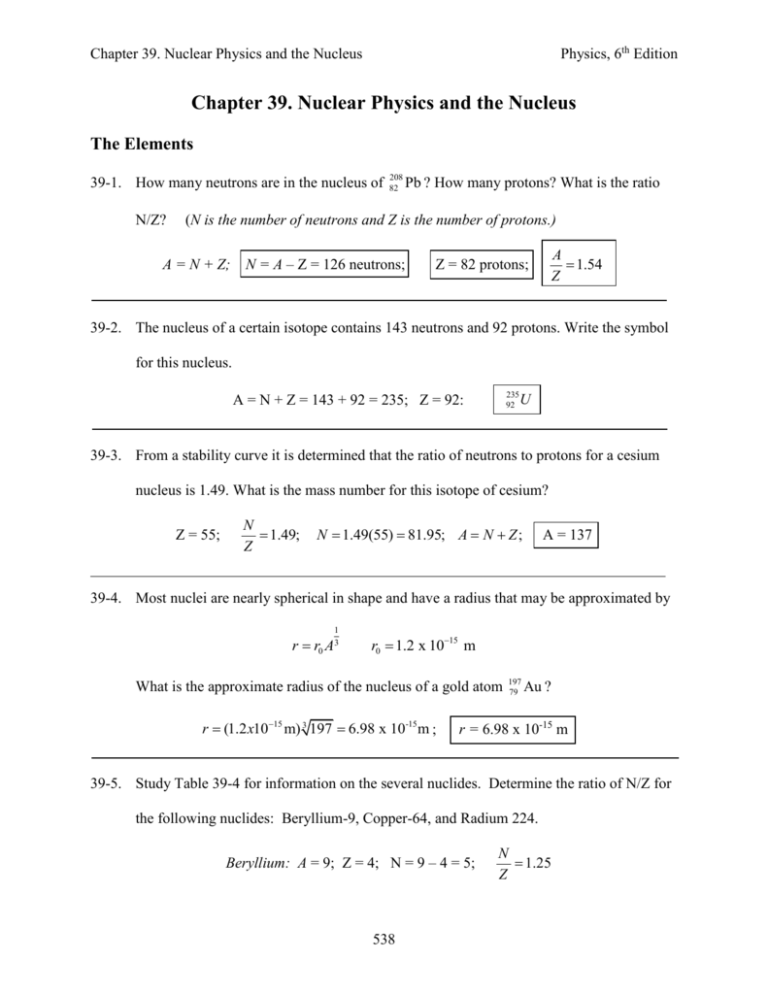
Physics, 6th Edition Chapter 39. Nuclear Physics and the Nucleus Chapter 39. Nuclear Physics and the Nucleus The Elements 39-1. How many neutrons are in the nucleus of N/Z? 208 82 Pb ? How many protons? What is the ratio (N is the number of neutrons and Z is the number of protons.) A = N + Z; N = A – Z = 126 neutrons; A 1.54 Z Z = 82 protons; 39-2. The nucleus of a certain isotope contains 143 neutrons and 92 protons. Write the symbol for this nucleus. 235 92 A = N + Z = 143 + 92 = 235; Z = 92: U 39-3. From a stability curve it is determined that the ratio of neutrons to protons for a cesium nucleus is 1.49. What is the mass number for this isotope of cesium? Z = 55; N 1.49; Z N 1.49(55) 81.95; A N Z ; A = 137 39-4. Most nuclei are nearly spherical in shape and have a radius that may be approximated by 1 r r0 A3 r0 1.2 x 1015 m What is the approximate radius of the nucleus of a gold atom r (1.2 x1015 m) 3 197 6.98 x 10-15 m ; 197 79 Au ? r = 6.98 x 10-15 m 39-5. Study Table 39-4 for information on the several nuclides. Determine the ratio of N/Z for the following nuclides: Beryllium-9, Copper-64, and Radium 224. Beryllium: A = 9; Z = 4; N = 9 – 4 = 5; 538 N 1.25 Z Physics, 6th Edition Chapter 39. Nuclear Physics and the Nucleus 39-5. (Cont.) Copper: A = 64; Z = 29; N = 64 – 29 = 35; N 1.21 Z Radium: A = 224; Z = 88; N = 224 – 88 = 136; N 1.55 Z The Atomic Mass Unit 39-6. Find the mass in grams of a gold particle containing two million atomic mass units? 1.66 x 10-27 kg m 2 x 106 u ; 1.00 u m = 3.32 x 10-21 kg 39-7. Find the mass of a 2-kg copper cylinder in atomic mass units? In Mev? In joules? 1u m 2 kg ; -27 1.6606 x 10 kg 931 MeV m = 1.204 x 1027 u ; 1u m = 1.20 x 1027 u m = 1.12 x 1030 MeV 1.6 x 10-13J m = 1.12 x 10 MeV ; 1 MeV 30 m = 1.79 x 1017 J 39-8. A certain nuclear reaction releases an energy of 5.5 MeV. How much mass (in atomic mass units) is required to produce this energy? 1u m 5.5 MeV ; 931 MeV m = 0.00591 u 39-9. The periodic table gives the average mass of a silver atom as 107.842 u. What is the average mass of the silver nucleus? (Recall that me = 0.00055 u ) For silver, Z = 47. Thus, the nuclear mass is reduced by the mass of 47 electrons. m = 107.842 u – 47(0.00055 u); 539 m = 107.816 u Physics, 6th Edition Chapter 39. Nuclear Physics and the Nucleus *39-10. Consider the mass spectrometer as illustrated by Fig. 39-3. A uniform magnetic field of 0.6 T is placed across both upper and lower sections of the spectrometer., and the electric field in the velocity selector is 120 V/m. A singly charged neon atom (+1.6 x 10-19 C) of mass 19.992 u passes through the velocity selector and into the spectrometer. What is the velocity of the neon atom as it emerges from the velocity selector? v E 120, 000 V/m ; B 0.6 T v = 2 x 105 m/s R *39-11. What is the radius of the circular path followed by the neon atom of Problem 19-10? B = 0.6 T into paper 1.66 x 10-27 kg 26 m 19.992 u 3.32 x10 kg 1 u mv 2 qvB; R mv ; R qB (3.32 x 10-27 kg)(2 x 105m/s) R ; (1.6 x 10-19C)(0.600 T) R = 6.92 cm Mass Defects and Binding Energy (Refer to Table 39-4 for Nuclidic Masses.) *39-12. Calculate the mass defect and binding energy for the neon-20 atom 20 10 Ne . mD [(ZmH Nmn )] M 10(1.007825 u) 10(1.008665 u) 19.99244 u mD = 20.016490 u –19.99244 u ; mD = 0.17246 u 931 MeV E mD c 2 (0.17246 u) 160.6 MeV ; 1u E = 161 MeV *39-13. Calculate the binding energy and the binding energy per nucleon for tritium 13 H . How much energy in joules is required to tear the nucleus apart into its constituent nucleons? mD [(ZmH Nmn )] M 1(1.007825 u) 2(1.008665 u) 3.016049 u 540 Physics, 6th Edition Chapter 39. Nuclear Physics and the Nucleus 39-13. (Cont.) mD = 0.009106 u; E = 8.48 MeV; 931 MeV E mD c 2 (0.009106 u) 8.48 MeV 1u EB 8.48 MeV ; A 3 EB 2.83 MeV/nucleon A Energy to tear apart: EB = 8.48 MeV(1.6 x 10-13 J/MeV) = 1.36 x 10-12 J *39-14. Calculate the mass defect of 73 Li . What is the binding energy per nucleon? mD [(ZmH Nmn )] M 3(1.007825 u) 4(1.008665 u) 7.016930 u mD = 7.058135 u –7.016930 u ; mD = 0.041205 u 931 MeV E mD c 2 (0.041205 u) 38.4 MeV ; 1u EB 38.4 MeV ; A 7 E = 38.4 MeV EB 5.48 MeV/nucleon A *39-15. Determine the binding energy per nucleon for carbon-12 ( 12 6 C ). mD 6(1.007825 u) 6(1.008665 u) 12.0000 u 0.09894 u 931 MeV E mD c 2 (0.09894 u) ; 1u EB 92.1 MeV = 7.68 MeV/nucleon A 12 *39-16. What is the mass defect and the binding energy for a gold atom 197 79 Au ? mD 79(1.007825 u) 118(1.008665 u) 196.966541 u 1.674104 u 931 MeV E mD c 2 (1.674104 u) 1.56 GeV; 1u EB 1.56 GeV = 7.91 MeV/nucleon A 197 541 Physics, 6th Edition Chapter 39. Nuclear Physics and the Nucleus *39-17. Determine the binding energy per nucleon for tin-120 ( 120 50 Sn ). mD 50(1.007825 u) 70(1.008665 u) 119.902108 u 1.09569 u EB (1.09569 u)(931 MeV/u ; A 120 EB 8.50 MeV/nucleon A Radioactivity and Nuclear Decay 39-18. The activity of a certain sample is rated as 2.8 Ci. How many nuclei will have disintegrated in a time of one minute? 3.7 x 1010s-1 Nuclei 2.8 Ci (60 s); 1 Ci 60 27 39-19. The cobalt nucleus nuclei = 6.22 x 1012 nuclei Co emits gamma rays of approximately 1.2 MeV. How much mass is lost by the nucleus when it emits a gamma ray of this energy? 1u E 1.2 MeV ; 931 MeV m = 0.00129 u 39-20. The half-life of the radioactive isotope indium-109 is 4.30 h. If the activity of a sample is 1 mCi at the start, how much activity remains after 4.30, 8.60, and 12.9 h? 1 R R0 2 1 R R0 2 1 R R0 2 t / T½ 1 t 4.3 h 1; T½ 4.3 h 1 R (1 mCi) ; 2 ; t 8.6 h 2; T½ 4.3 h 1 R (1 mCi) ; 2 ; t 12.9 h 3; T½ 4.3 h 1 R (1 mCi) ; 2 ; t / T½ t / T½ R = 0.5 mCi 2 542 R = 0.25 mCi 3 R = 0.125 mCi Physics, 6th Edition Chapter 39. Nuclear Physics and the Nucleus 39-21. The initial activity of a sample containing 7.7 x 1011 bismuth-212 nuclei is 4.0 mCi. The half-life of this isotope is 60 min. How many bismuth-212 nuclei remain after 30 min? What is the activity at the end of that time? t / T½ 1 N N0 2 ½ t 30 min 1 ; 0.5; N (7.7 x 1011 ) = 5.44 x 1011 nucl. T½ 60 min 2 1 R R0 2 t / T½ ½ 1 R (4 mCi) ; 2 ; R = 2.83 mCi *39-22. Strontium-90 is produced in appreciable quantities in the atmosphere during a nuclear explosion. If this isotope has a half-life of 28 years, how long will it take for the initial activity to drop to one-fourth of its original activity? n 1 R R0 ; 2 n n R 1 1 ; n2 R0 2 4 t t 2; T½ 28 yr t 2(28 yr); t = 56 yr *39-23. Consider a pure, 4.0-g sample of radioactive Gallium-67. If the half-life is 78 h, how much time is required for 2.8 g of this sample to decay? When 2.8 g decay, that leaves 4 g – 2.8 g or 1.20 g remaining. n 1 m m0 ; 2 m 1.2 g 0.300; m0 4g n 1 0.300 2 The solution is accomplished by taking the common log of both sides: n log(0.5) log(0.300); n 0.301n 0.523; t t 1.74; T½ 78 h t = 1.74 (78 h) 543 n 0.523 1.74 0.301 t = 135 h Physics, 6th Edition Chapter 39. Nuclear Physics and the Nucleus *39-24. If one-fifth of a pure radioactive sample remains after 10 h, what is the half-life? n 1 1 ; 5 2 0.200 = (0.5) n ; n log(0.5) log(0.2); n t 10 h 2.32; T½ T½ T½ 10 h ; 2.32 0.301 n 0.699 T½ = 4.31 h Nuclear Reactions *39-25. Determine the minimum energy released in the nuclear reaction 19 9 The atomic mass of E 19 9 19 9 F 11 H 24 He + 16 8 O + energy F is 18.998403 u, 4 2 He 4.002603 u, 1 1 H = 1.007824 u. F + 11H - 42 He - 16 (Energy comes from mass defect) 8 O ; E = 18.998403 u + 1.007825 u – 4.002603 – 15.994915 u = 0.0087 u 931 MeV E (0.00871 u) ; 1u E = 8.11 MeV *39-26. Determine the approximate kinetic energy imparted to the alpha particle when Radium226 decays to form Radon-222. Neglect the energy imparted to the radon nucleus. 226 88 Ra 222 86 Rn + 24 He + Energy; 226 88 Ra = 226.02536 931 MeV E 226.02536 u - 222.017531 u - 4.002603 u = 0.00523 u = 4.87 MeV 1u *39-27. Find the energy involved in the production of two alpha particles in the reaction 7 3 Li 11H 42 He 42 He + energy 931 MeV E 7.016003 u + 1.007825 u - 2(4.002603 u) = 0.018622 u = 17.3 MeV 1u 544 Physics, 6th Edition Chapter 39. Nuclear Physics and the Nucleus *39-28. Compute the kinetic energy released in the beta minus decay of thorium-233. 233 90 Th 233 91 Pa + 0+1 + energy; 233 90 Th = 233.041469 u; 233 91 Pa = 233.040130 E 233.041469 u - 233.040130 u - 0.00055 u = 0.000789 u 931 MeV E 0.000789 u ; 1u E = 0.735 MeV *39-29. What must be the energy of an alpha particle as it bombards a Nitrogen-14 nucleus producing 17 8 O and 11H? (17 8 O = 16.999130 u) . 4 2 He + 14 7 N + Energy 17 8 O + 11H 931 MeV E 16.999130 u + 1.007825 u - 14.003074 - 4.002603 u = 0.001278 u 1u E = 1.19 MeV This is the Threshold Energy for the reaction Challenge Problems *39-30. What is the average mass in kilograms of the nucleus of a boron-11 atom? 1.66 x 10-27 kg m 11.009305 u ; 1.00 u m = 1.83 x 10-26 kg *39-31. What are the mass defect and the binding energy per nucleon for boron-11? mD [(ZmH Nmn )] M 5(1.007825 u) 6(1.008665 u) 11.009305 u mD = 11.09112 u –11.009305 u ; mD = 0.08181 u 931 MeV E mD c 2 (0.08181 u) 76.2 MeV ; 1u EB 76.2 MeV ; A 11 E = 76.2 MeV EB 6.92 MeV/nucleon A 545 Physics, 6th Edition Chapter 39. Nuclear Physics and the Nucleus *39-32. Find the binding energy per nucleon for Thallium-206. mD 81(1.007825 u) 125(1.008665 u) 205.976104 u 1.740846 u 931 MeV E mD c 2 (1.740846 u) ; 1u EB 1621 MeV = 7.87 MeV/nucleon A 206 *39-33. Calculate the energy required to separate the nucleons in mercury-204. mD 80(1.007825 u) 124(1.008665 u) 203.973865 u 1.7266 u 931 MeV E mD c 2 (1.7266 u) ; 1u EB = 1610 MeV *39-34. The half-life of a radioactive sample is 6.8 h. How much time passes before the activity drops to one-fifth of its initial value? n R 1 1 ; R0 5 2 n 0.200 = (0.5) n ; n log(0.5) log(0.2); 0.699 t 6.8 h 2.32; n 2.32; 0.301 T½ T½ T½ 6.8 h ; 2.32 0.301 n 0.699 T½ = 2.93 h *39-35. How much energy is required to tear apart a deuterium atom? (12 H 2.014102 u) mD 1(1.007825 u) 1(1.008665 u) 2.014102 u 0.002388 u 931 MeV E mD c 2 (0.002388 u) ; 1u 546 EB = 2.22 MeV Physics, 6th Edition Chapter 39. Nuclear Physics and the Nucleus *39-36. Plutonium-232 decays by alpha emission with a half-life of 30 min. How much of this substance remains after 4 h if the original sample had a mass of 4.0 g? Write the equation for the decay? 1 m m0 2 t / T½ t 4h 8.00; T½ 0.5 h ; 232 94 Pu 228 92 8 1 m (4 g) ; 2 m = 15.6 mg U + 42 He + energy *39-37. If 32 x 109 atoms of a radioactive isotope are reduced to only 2 x 109 atoms in a time of 48 h, what is the half-life of this material? n N 2 x 109 1 ; 0.0625 = (0.5) n ; n log(0.5) log(0.0625); 0.301 n 1.204 9 N0 32 x 10 2 n 1.204 t 48 h 4.00; n 4.00; 0.301 T½ T½ T½ 48 h ; 4.00 T½ = 12.0 h *39-38. A certain radioactive isotope retains only 10 percent of its original activity after a time of 4 h. What is the half-life? n N 1 1 ; 0.100 = (0.5) n ; n log(0.5) log(0.100); 0.301 n 1.00 N0 10 2 n 1.00 t 4h 3.32; n 3.32; 0.301 T½ T½ T½ 4h ; 3.32 T½ = 72.3 min *39-39. When a 63 Li nucleus is struck by a proton, an alpha particle and a produce nucleus are released. Write the equation for this reaction. What is the net energy transfer in this case? 6 3 Li 11H 42 He 32 He + energy 931 MeV E 6.015126 u + 1.007825 u - 4.002603 u - 3.016030 = 0.00432 u = 4.02 MeV 1u 547 Physics, 6th Edition Chapter 39. Nuclear Physics and the Nucleus *39-40. Uranium-238 undergoes alpha decay. Write the equation for the reaction and calculate the disintegration energy. 238 92 U 224 90 Th + 24 He + energy E 238.05079 u - 234.04363 u - 4.002603 u = 0.00456 u 931 MeV E 0.00456 u ; 1u E = 4.24 MeV *39-41. A 9-g sample of radioactive material has an initial activity of 5.0 Ci. Forty minutes later, the activity is only 3.0 Ci. What is the half-life? How much of the pure sample remains? n R 3 Ci 1 ; R0 5 Ci 2 n 0.600 = (0.5)n ; n log(0.5) log(0.6); 0.222 t 40 min 0.737; n 0.737; 0.301 T½ T½ n 1 1 m m0 (9 g) 2 2 T½ 40 min ; 0.737 0.301 n 0.222 T½ = 54.3 min 0.737 m = 5.40 g Critical Thinking Problems *39-42. Nuclear fusion is a process that can produce enormous energy without the harmful byproducts of nuclear fission. Calculate the energy released in the following nuclear fusion reaction: 3 2 H 32 He 24 He 11 H+11H energy 931 MeV E 2(3.016030 u) - 4.002603 u - 2(1.007825 u) = 0.013807 u 1u E = 12.9 MeV 548 Physics, 6th Edition Chapter 39. Nuclear Physics and the Nucleus *39-43. Carbon-14 decays very slowly with a half-life of 5740 years. Carbon dating can be accomplished by seeing what fraction of carbon-14 remains, assuming the decay process began with the death of a living organism. What would be the age of a chunk of charcoal if it was determined that the radioactive C-14 remaining was only 40 percent of what would be expected in a living organism? n R 1 0.40 ; R0 2 n 0.400 = (0.5) n ; n log(0.5) log(0.4); 0.399 t t 0.737; n 1.32; 0.301 T½ 5740 yr 0.301 n 0.399 t 1.32(5740 yr); t = 7590 yr *39-44. The velocity selector in a mass spectrometer has a magnetic field of 0.2 T perpendicular to an electric field of 50 kV/m. The same magnetic field is across the lower region. What is the velocity of singly charged Lithium-7 atoms as they leave the selector? If the radius of the path in the spectrometer is 9.10 cm, find the atomic mass of the lithium atom? v E 50, 000 V/m ; B 0.2 T v = 2.5 x 105 m/s mv 2 qBR (1.6 x 10-19C)(0.2 T)(0.091 m) qvB; m ; m ; R v (2.5 x 105m/s) 1u m = 1.165 x 10-26 kg ; -27 1.66 x 10 kg m = 7.014 u R B = 0.2 T into paper *39-45. A nuclear reactor operates at a power level of 2.0 MW. Assuming that approximately 200 MeV of energy is released for a single fission of U-235, how many fission processes are occurring each second in the reactor? P 2 x 106 J/s 1.25 x 1019 MeV/s 19 1.25 x 10 MeV/s; 6.25 x 10216 fissions/s -19 1.6 x 10 J/MeV 200 MeV/fission 549 Physics, 6th Edition Chapter 39. Nuclear Physics and the Nucleus *39-46. Consider an experiment which bombards 14 7 N with an alpha particle. One of the two product nuclides is 11 H . The reaction is 4 2 A 1 He 14 7 N Z X 1 H What is the product nuclide indicated by the symbol X? How much kinetic energy must the alpha particle have in order to produce the reaction? Conservation of nucleons means: 4 2 He 14 7 N + enery 17 8 O 11 H E 16.99913 u + 1.007825 u - 4.002603 u - 14.003074 u = 0.001282 u 931 MeV E 0.001282 u ; 1u E = 1.19 MeV *39-47. When passing a stream of ionized lithium atoms through a mass spectrometer, the radius of the path followed by 73 Li (7.0169 u) is 14.00 cm. A lighter line is formed by the 63 Li (6.0151 u). What is the radius of the path followed by the 6 3 Li isotopes? mv 2 mv qvB; R ; (See Problems 39-10 and 39-11) R qB m1 R1 ; m2 R2 R2 m2 R1 (6.0151 u)(14 cm) ; m1 7.0169 u 550 R2 = 6.92 cm

